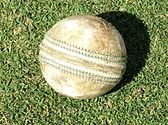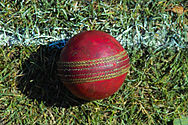Bat and ball
Main articles: Cricket bat and Cricket ball
The essence of the sport is that a bowler delivers the ball from his end of the pitch towards the batsman who, armed with a bat is "on strike" at the other end.
The bat is made of wood (usually White Willow) and has the shape of a blade topped by a cylindrical handle. The blade must not be more than 4.25 inches (108 mm) wide and the total length of the bat not more than 38 inches (970 mm).
The ball is a hard leather-seamed spheroid, with a circumference of 9 inches (230 mm). The hardness of the ball, which can be delivered at speeds of more than 90 miles per hour (140 km/h), is a matter for concern and batsmen wear protective clothing including pads (designed to protect the knees and shins), batting gloves for the hands, a helmet for the head and a box inside the trousers (to protect the crotch area). Some batsmen wear additional padding inside their shirts and trousers such as thigh pads, arm pads, rib protectors and shoulder pads. The ball has a "seam": six rows of stitches attaching the leather shell of the ball to the string and cork interior. The seam on a new ball is prominent, and helps the bowler propel it in a less predictable manner. During cricket matches, the quality of the ball changes to a point where it is no longer usable, and during this decline its properties alter and thus influence the match.


No comments:
Post a Comment